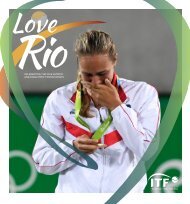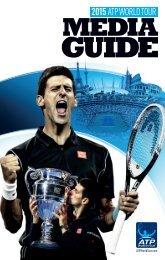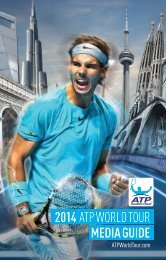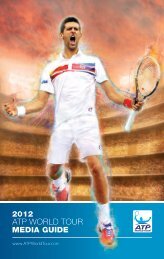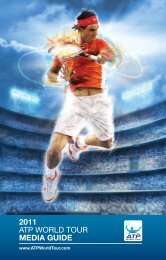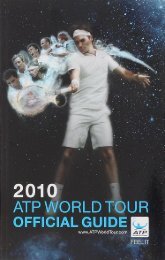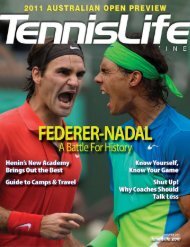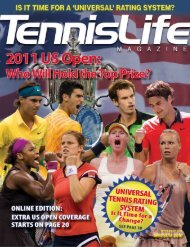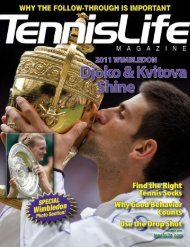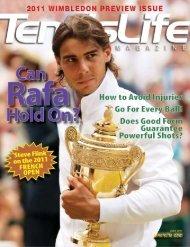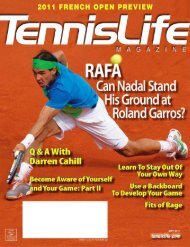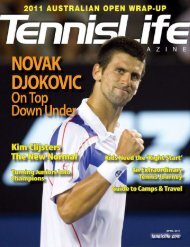A Champion's Mind - Pete Sampras
www.tennismoscow.me Insta:TENNISMOSCOW
www.tennismoscow.me Insta:TENNISMOSCOW
You also want an ePaper? Increase the reach of your titles
YUMPU automatically turns print PDFs into web optimized ePapers that Google loves.
I was within one match of Emerson’s record twelve Grand Slam singles titles as I left Wimbledon, and<br />
there was no better place to equal his mark than at the U.S. Open. But I lost at Flushing Meadows to the<br />
swashbuckling Australian with the samurai topknot and zinc-oxide war paint, Pat Rafter. I would have<br />
made the rest of my life that year a lot easier if I had managed to win in New York, because it would have<br />
spared me having to undertake a late-season push to clinch the number one spot for a record sixth<br />
consecutive year.<br />
As I looked at my prospects for the fall of 1998, I realized that I had no appetite for the indoor<br />
European events that take place after the Grand Slams are all done. Six or seven years earlier, I wanted to<br />
win everything. For years, the mileage on my odometer had been building up, and while my engine hadn’t<br />
lost any pep, my shocks were getting worn and things were beginning to break. For an athlete, that means<br />
injuries, or moments when the mind just snaps and fails to focus in the correct, relaxed way that helps you<br />
win tennis matches. All those years at number one took a lot out of me, and had me thinking a lot more<br />
about peaking at the right, choice times of the year—meaning, for the Grand Slams.<br />
Nevertheless, I was determined to make a push for that ironman record of most years at number one. It<br />
may not be as spectacular a record as the Grand Slam singles title mark, but in many ways it’s more<br />
significant because greatness begins and ends with going out there, day after day, and getting the job done,<br />
learning to live and survive with that target on your back. The essence of greatness is consistency.<br />
I’m often asked to name the GOAT (Greatest of All Time), and to me there are five guys in that<br />
conversation if you count guys who played at least a significant portion of their careers in the Open era<br />
that began in 1968. In all honesty, I just don’t feel qualified to judge the great players of the amateur era,<br />
when top players turned pro and were barred from playing the Grand Slams. My five guys are Rod Laver,<br />
Björn Borg, Ivan Lendl, Roger Federer, and—no arrogance intended—me. My reasoning is pretty simple:<br />
to me, the GOAT was not just a guy who won X number of titles, or who finished on top X number of<br />
years; he’s also the one who came closest to dominating his main rivals throughout his career.<br />
Some people may ask, “Lendl?” Well, yes, because Ivan really transcended the game in his time. His<br />
record against Connors was an amazing 22–13 and against McEnroe he was 21–15. How do you argue<br />
with that? And Connors had a nemesis in Borg, while McEnroe was manhandled frequently by Lendl. The<br />
only thing Lendl lacked was good PR, and the charisma people want in a great champion. He was in the<br />
final of the U.S. Open eight consecutive years—and the Open is thought by many to be the most demanding<br />
of the majors. So those are my top guys, with all due respect to Connors, McEnroe, and Andre Agassi,<br />
whom I put in the second five of my all-time top ten.<br />
It’s interesting to compare the feat of breaking Emerson’s singles title record (twelve Slams) with the<br />
accomplishment of finishing at number one for six years in a row. A player can equal Emerson’s record by<br />
winning two majors a year for six years. That isn’t too great an ask, given that a great grass- or clay-court<br />
player could win just one tournament on a less desirable surface to get those two majors. Six years is a<br />
pretty reasonable window, given that McEnroe is the only one among the great players who won all of his<br />
majors in a span of fewer than seven years (Connors won majors almost ten years apart). Seven years is<br />
twenty-eight Grand Slam events; to win twelve is a massive achievement, but not unthinkable.<br />
So you’re really talking about a month of great tennis out of every year and you have your twelve<br />
majors. The rest of the time, you can hide, relax, or plot your strategy while marshaling your resources.<br />
But you can’t do that if you want to finish number one. You don’t get that top spot unless you play and win<br />
a lot of tournaments and matches over the course of the year. Most players would trade majors for<br />
consistency any day, much like most baseball players would rather be on a World Series winner once than<br />
a team that finishes tops in its league for years but never takes the fall classic. But the best of players win<br />
big, and they win often. They grind.<br />
Ultimately, it was grinding that almost undid me in that period in 1988 when I was driving to capture



